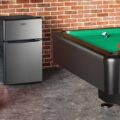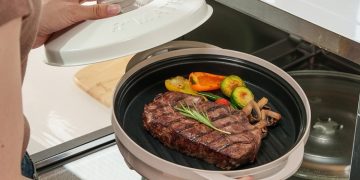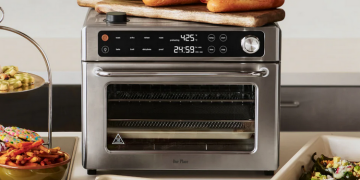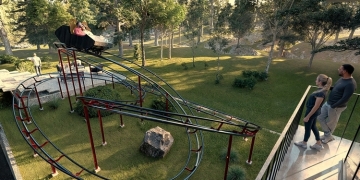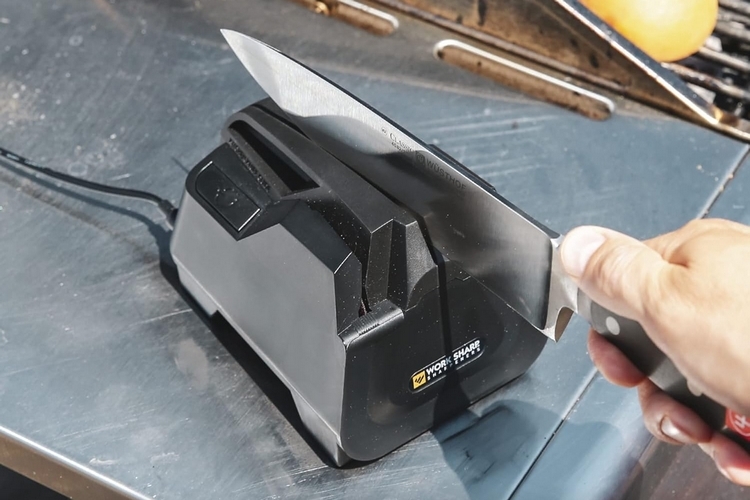
Even the best chef’s knives will dull out eventually. That’s just what happens when you use a blade over and over. For most people, we’d recommend just getting your knife professionally sharpened, especially if you can find local businesses offering the service. It’s not that expensive and you save yourself a lot of potential headache. However, it is possible to sharpen your own kitchen knives safely and effectively at home. You just need the right tools and a basic knowledge of what you need to do.
The best knife sharpeners can either be manual or electric-powered. In manual designs, you rely on elbow grease to move the blade edge across an abrasive surface, sharpening it with each stroke. With traditional designs, the abrasive is stationary and you move the blade back and forth. However, there are also some portable blade sharpener designs where the abrasive is the one you manually move across the length of the blade edge. Electric knife sharpeners, on the other hand, provide a moving abrasive (that usually rotates), requiring you to simply hold the blade in place to make contact with it. As you can imagine, the latter will allow you to sharpen knives much faster than manual offerings.
What about whetstones? While whetstones are excellent knife sharpeners, they do require a lot more skill than either manual or electric-powered variants. They do, however, give you the most control, while also putting minimal toll on the blade, which should promote better longevity for you knives. Because of the skill level required, we decided not to include it in the list, as this is more focused on the kind of knife sharpeners absolute novices can easily use at home.
These are the best knife sharpeners to keep your kitchen blades in tip-top shape.
Zwilling J.A. Henckels 4-Stage Pull-Through Knife Sharpener
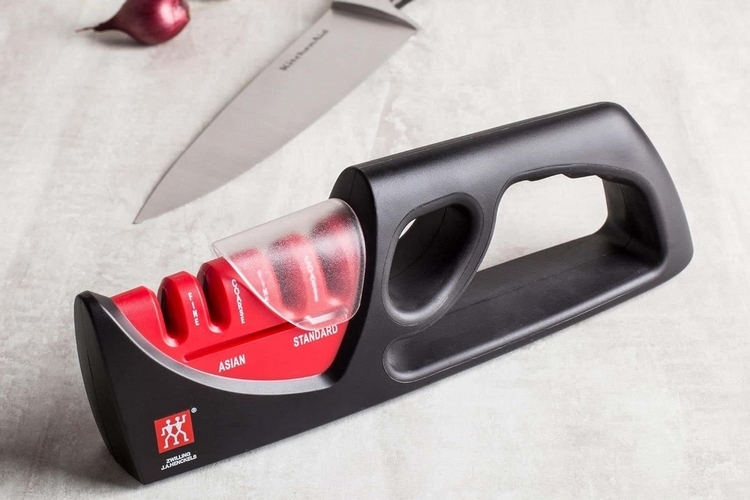
Pros
- Affordable
- Sharpens very effectively
- Two coarseness types and two edge angles
Cons
- Easy to hold the knife wrong and mess it up
Type: Manual
Abrasive material: Ceramic
Sharpening options: 15 degrees (coarse and fine), 10 degrees (coarse and fine)
This is easily our favorite of the manual knife sharpeners we tried out. It’s simple, well-appointed, and got our old kitchen knives feeling absolutely like new. It did require quite a bit of work and a good amount of time to get there, as we did around 50 strokes on each side of the blade against the coarse abrasive and another 50 strokes on each side on the fine abrasive (those are rough numbers, we didn’t keep perfect count). It’s worth it, though, since the blades looked absolutely polished with zero scratches. Sure, it’s still a lot of grunt work compared to an electric model, but you’re also not going to find electric sharpeners at this inexpensive price range that can yield this type of result. It has separate slots for West- and Japanese-style knives, by the way, so you get two angle options, along with the coarse and fine abrasives. The only real issue here is that you already have to know what you’re doing, since the slots can accommodate different blade thicknesses, requiring you to fine-tune the placement and ensure you’re setting up at a correct angle all by yourself. We recommend seeing a few YouTube videos before working on your first knife (or using a cheap throwaway one).
Presto EverSharp Two-Stage Electric Knife Sharpener
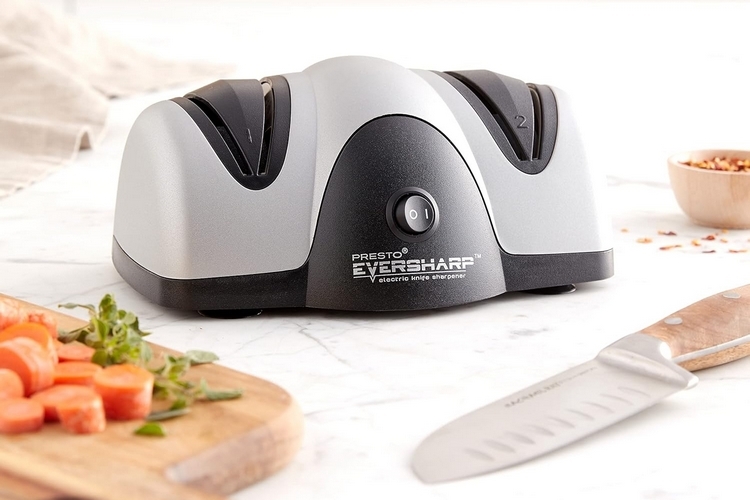
Pros
- Inexpensive for an electric model
- Auto-stalls when you put too much pressure
- Runs quiet
Cons
- A bit too sensitive to pressure
Type: Electric
Abrasive material: Sapphirite (synthetic)
Sharpening options: 20-degrees (coarse and fine)
We did try a couple of cheap electric knife sharpeners. So far, this is the best that we’ve found. Our favorite part is the auto-stall feature that activates when it detects you’re applying too much pressure (the kind that can dull instead of sharpen a knife), making this very friendly to novice users. It does feel a bit too sensitive, though, but we guess they would rather err towards caution to ensure you don’t end up ruining a perfectly good kitchen knife. We don’t mind it. It’s a two-step design, by the way, with each side clearly marked with either 1 or 2, so you know which side to put the knife on first. And yes, it produced very sharp edges while making very little sound. While it doesn’t sharpen as fast or as cleanly as more expensive sharpeners, we imagine most people will be happy with the impressively sharp results they can get from here, especially at this affordable price.
Work Sharp Electric Culinary E2
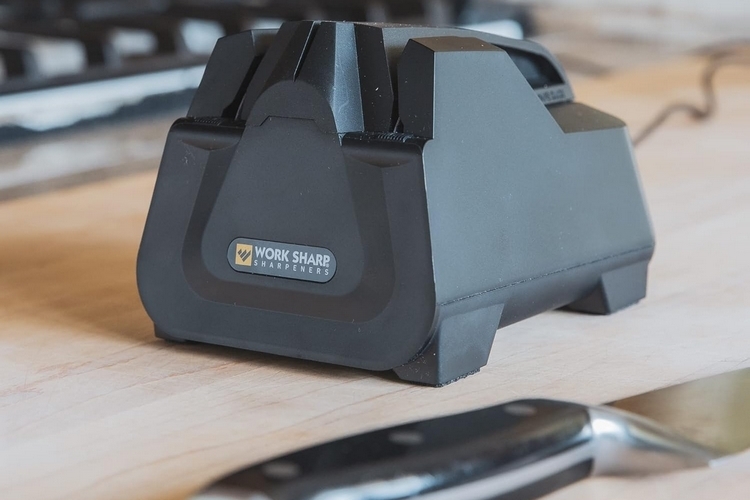
Pros
- Built-in timer prevents over-sharpening
- Easy to use correctly
- Sharpens serrated knives and scissors
Cons
- Sharpens to low edge height
Type: Electric
Abrasive material: White aluminum oxide, ceramic
Sharpening options: 20 degrees (coarse, fine)
We love the simple design of this electric knife sharpener’s slots, as it leaves no room to misinterpret how you should be aligning the knife every time you do a stroke. There’s very little room to make a mistake. They even extended this to the sharpening time, as it comes with a built-in timer that automatically shuts off the machine after a set period. We do think the preset times are a little short (50, 40, and 10 seconds, depending on the setting you choose), although it seems they were meant for quick touch-ups rather than reworking a badly-dulled blade. Still, it’s a nice gesture to keep novices from making mistakes. Similar to the Presto model above, this takes a bit of time to sharpen your knives to that razor-sharp edge, especially if it’s been badly-dulled through the years. It’s worth the time investment, though, especially since you’ll only be needing this for quick touch-ups every few months after that (unless, of course, you just let it dull out again). The sharpness you get here is comparable to the Presto, maybe even a little better, but not quite as clean or polished as the more expensive options in the list. For home use, though, this is all the sharpness that most people want, so it will absolutely get the job done. It sharpened every blade we tried, by the way, including serrated ones, so you should be able to use it for all your kitchen knives.
Tumbler Rolling Knife Sharpener
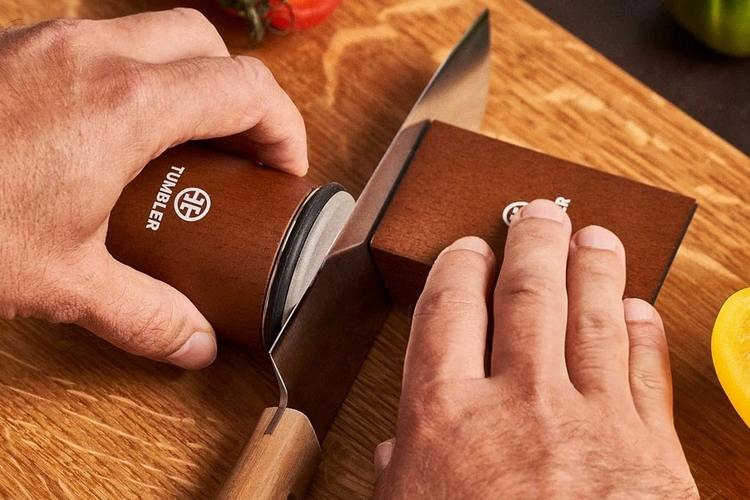
Pros
- Foolproof rolling design
- Perfect sharpening angles each time out
- Easy to use
Cons
- Hard to use for larger and smaller knives
Type: Rolling (manual)
Abrasive material: Diamond, steel helix
Sharpening options: 15 and 20 degrees
The rolling knife sharpener is still a pretty new concept to many people. Heck, we only heard about it around two years ago when Work Sharp released a rolling model. We’re not sure who pioneered it, but it’s such a clever and foolproof way to sharpen a knife. This model pairs a diamond abrasive wheel with a magnetic block that holds the knife perfectly still at either a 15-dewgree or 20-degree angle. Once the knife is secured onto the block, you just roll the wheel back and forth several times, then do the other side of the blade. You can finish off by using the stainless steel side of the wheel on both sides to clean off any burrs. If you want an easy-to-use knife sharpener that’s impossible to use incorrectly, rolling sharpeners are definitely the way to go. It delivers a really good, really sharp edge, albeit not at the same level as the best electric models. While it works well for standard-sized kitchen knives, it’s a bit tougher for small paring knives and large cleavers. Basically, you’ll need to use some workarounds. In our case, we placed extra material below the paring knife to sharpen it and rolled the wheel on a two-stack of cutting boards to make it reach the large cleaver. It’s not convenient, but we made it work (kind of).
Work Sharp Ken Onion Knife Sharpener Mk 2
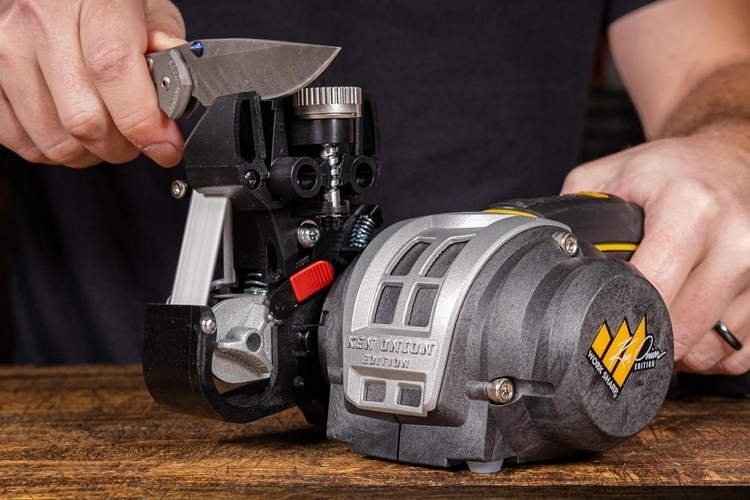
Pros
- Extremely versatile sharpener
- Sharpens fast
- Surprisingly easy to use
Cons
- Overkill for most
- Loud
Type: Electric
Abrasive material: Belt
Sharpening options: 10 to 35 degrees, six abrasion levels
This is easily the most intimidating of the knife sharpeners we have here. We mean… it looks more like a workshop power tool than something you want to keep somewhere in the kitchen. That’s largely because it’s not just designed to sharpen your kitchen knives – this thing can handle everything from scissors and axe blades to mower blades and more. Because of this versatility, it comes with six different abrasive belts, while the built-in motor can run at any of seven speed settings. To make it less intimidating, the sharpener allows you to set the blade guide angle from 10 to 35 degrees, so just follow the guide to ensure you have the blade at the right position every time. For kitchen knives, specifically, we use the X22 belt (medium coarse) and the #3 speed setting to produce a near factory-sharp edge with no burrs or scratches. The manual recommends around four to eight pulls on each side, but we did quite a bit more until we got the edge we wanted. It’s still plenty fast, though, delivering that impeccable edge in very short order, compared to much cheaper knife sharpeners. Basically, if you want an all-around sharpener for your knives and tools, this is the way to go.
Chef’sChoice Model 1520
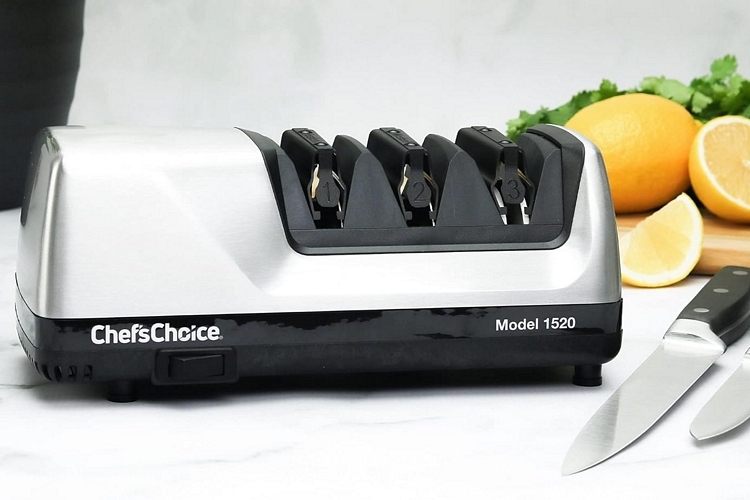
Pros
- Spring-loaded guide ensure perfect angle
- Consistent and reliable
- Sharpens very fast
Cons
- Large size
- Expensive
Type:
Abrasive material: Diamond
Sharpening options: 15 and 20 degrees (coarse), polishing
In our opinion, the Work Sharp above offers the best value in knife sharpeners, since the darn thing can handle working the blade on every sharp tool you have around the house (including the mower blades). However, it’s a loud and messy tool, which is why we think this electric model will make a better pick for most home users. Provided, of course, you’re not going to balk at the $200 price. Yes, it’s expensive and, in all likelihood, overpriced. However, it is an incredibly consistent and reliable knife sharpener that can give the dullest blade a factory-fresh edge in just a couple of minutes. We love how easy it is to use, eliminating any chance of misaligned placements by using spring-loaded guides inside the slots. You do need to get the pressure and timing of the pull right (you want around a second per inch) for optimal results, although it still turned out well when we first started playing around (and probably getting the timing and pressure wrong). We love that it sharpened the entire length of the edge, as well, including the tip, which some sharpeners we tried did very poorly on.

